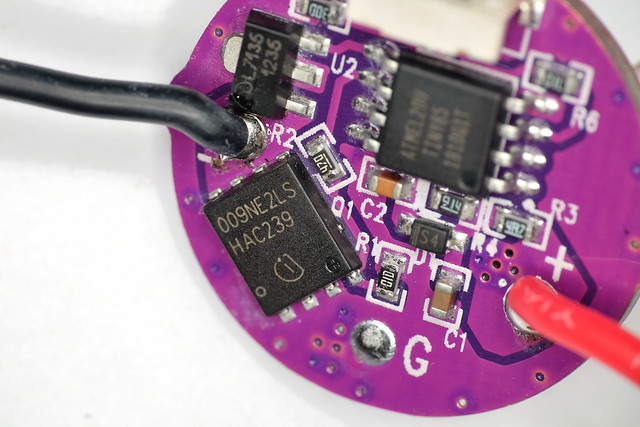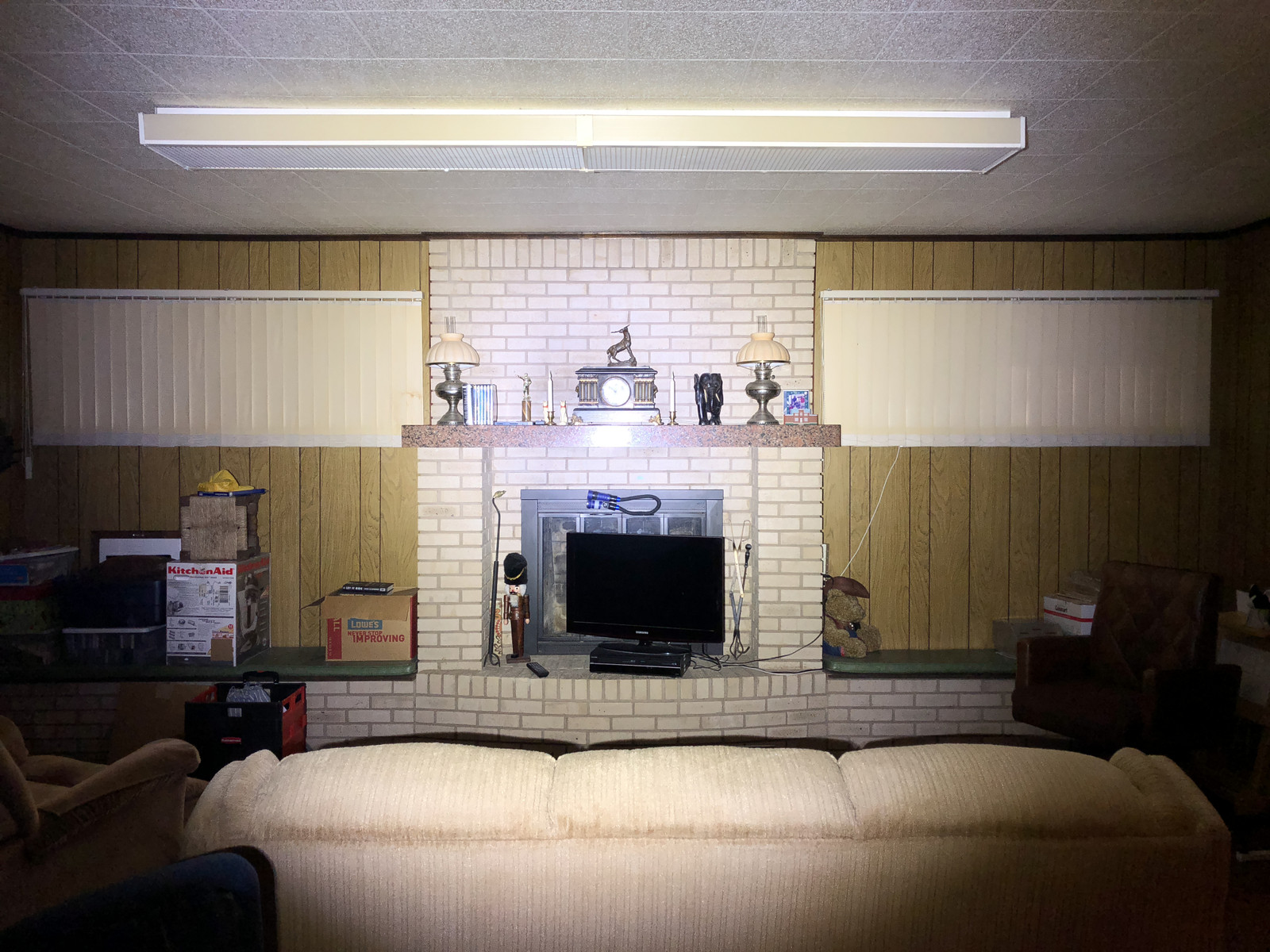“Brighter than the Sun” … a new D4S tag line. ![]()
Been doing some testing, here’s what I’ve learned. The MOSFET Hank chose actually outperforms a Vishay-Dale SIR404DP. ![]() Also, 20ga Teflon coated wires meet or exceed 18ga Turnigy silicone coated wires.
Also, 20ga Teflon coated wires meet or exceed 18ga Turnigy silicone coated wires. ![]() The 20ga Teflon wires are actually easier to install so they are probably the way to go with the caveat that you must be more careful as they are very stiff and can rip pads off the driver if you don’t do your part.
The 20ga Teflon wires are actually easier to install so they are probably the way to go with the caveat that you must be more careful as they are very stiff and can rip pads off the driver if you don’t do your part. ![]()
So, around 7300 lumens is the ceiling for the LG HG6 20650 cell. (Normally $11.00, they’re $6.97 as of now) This is a good thing though, as this cell was on sale at IMR Batteries for some $6 each recently. ![]()
I used a 7/8” round rasp file to cut down the ridges (4 of them) inside a clear plastic 26500-18650 spacer, this allows easy use of the 20650 cell and prevents ratting around. ![]()
Ceiling really needs to be set lower for the monster set-up, it will get hot faster than the temperature step-down can sense it. I have it at 27 steps below top (I think) and it makes 2535.75 lumens at this ceiling on the ramp. The 100% 7135 chip level is 507 lumens.
Color on this W6 Samsung emitter is quite pleasant, like it a lot.
Toykeeper:
First of all, your state machine firmware is exemplary. I will be studying it to improve my own microcontroller projects. Thank you.
Second, if you are looking for UI improvements, I would like to suggest to you that you look into the notion of intents. That is, a click has a different meaning depending on what has happened previously. This might be a simple addition to a state machine.
Recently a user asked about the delay time in turning off the light. The FSM does not know that the user wants to turn off the light, so there is a delay while it waits for future button presses. I suggest that there could be some sort of other “input” timer. If the user has not input something in X seconds, then the next input is interpreted differently. Similar to how the up/down ramp functionality works.
Maybe if the light has been on continuously for >120 seconds, the next press could dim the light to 0 (off) after the first press but if the button is pressed again, then it moves to other functions. I hope I have been clear enough for others to understand.
Ok wut?!
I’d like to know where he got it so I can order 10pcs.
Also, how could 20AWG Teflon wire be actually more conductive than 18AWG silicone wire? How does it work? The copper strands are not only larger, unless using less strands means a lower risk of strands coming off and upping resistance?
Neat stuff ![]()
And yeah, we are limited by storage capacity of the MCU. Unless you want to strap on a bare NAND package, if you actually could ![]()
lowprofile, keep in mind that there are capacity limitations in the MCU. ![]() Some things might be good ideas, implementing them in the avialable space can be the real trick.
Some things might be good ideas, implementing them in the avialable space can be the real trick.
Edit: ToyKeeper is truly exceptional in weighing the requirements of the community, if 4000 lights are selling, how many would want idea 1 or idea 2? Just because some think it’s critical to have something implemented they may be a scarce minority in the overall big picture. It becomes truly difficult to average out the requests and audible needs (those that have specifically had something in mind) and it can be quite taxing figuring out just what will make a light epic vs what will kill the sales.
We’re a rather manic bunch, it would seem. ![]()
DB Custom: what is the Hank’s FET? Maybe the Lexel’s one would be even better?
There are also 2 efficiency tricks that I haven’t seen tried (and measured):
- glue TIR and glass together with optical adhesive to eliminate reflections on the boundary
- paint the head, bezel, PCB white on the inside to turn some losses into flood.
Pretty sure Lexel recommended the FET Hank used. Infineon I believe it is. It’s not very much better than the 404 but it is slightly more output, only about 200 total lumens but hey, when you’re chasing em you chase ALL of em! ![]()
Optical adhesive, tricky stuff that. How are you going to set it? The lens blocks UV, the optic material blocks UV, can’t get UV light deep enough between the two to set the adhesive…
Paint the interior of the head with what, oven paint? Mine gets HOT! ![]() (got some 80 Watts going in this smallish light)
(got some 80 Watts going in this smallish light)
Each state gets an argument passed where you get the count how long (ticks) you are in this state.
I think you are free to add it with a new compiler switch and upload the changes for TK to merge into Anduril.
What options are there to increase storage capacity?
There are adhesives that don’t need UV curing.
This one is easy. Heater paint.
Use another microcontroller.
But there are a few problems with that:
- The Attiny85 is the biggest SOIC-8 ATtiny
- Small size
- Hand-solderable for DIY (so certainly no BGA and probably no QFN)
- Need to port existing firmware too it
I did a short search for matching ARM processors, but I couldn’t find a good and cheap replacement. Biggest hurdle is the package as there are small MCUs but they are made for industrial soldering processes or just hard to do at home (QFN, BGA, WLCSP, …)
I’m not criticizing or even trying to imply I know more, just trying to suggest something from the way I see it… I have limited experience in C/C and I know what a finite state machine is because I’ve wanted to create one for ages. I am not a programmer, just a programmer admirer.
I just had this idea that the flashlight might be able to figure out if the user intends to turn it off or to change the brightness based on simply considering how long it’s been since the button has been pressed (>5 seconds kind of thing). I wasn’t trying to say that anything wasn’t good enough. Sorry if I offended anyone.
It is also the same FET that’s used in the GT Mini BSC009NE2LS

I believe DEL actually found the Hyperon/Infineon MOSFET, according to the PM’s I got from TomE back in 9/1/17. At that time Lexel was using the (edit) SIR800.(not SIR404)
https://www.arrow.com/en/products/bsc009ne2ls5atma1/infineon-technologies-ag
I’m not sure how many people here are into photography, but with those settings you either have a very good camera or a very bright light. ![]()
I have an Apple i8, with an app that lets me control the camera manually. ![]()
And I have a very bright light. Or two…
For comparison purposes,
i8 at f/1.8, 120th of a second exposure at ISO 32. 4 times faster shutter, for a light that’s in the 20,000 lumens category (triple XHP-70.2 pulling 48A at the tail)
That is how the initial activation works from off. It may turn on at the requested level immediately, but it doesn’t actually change state until the timeout happens, in case there are more button presses coming.
I considered doing an immediate off depending on what the user had been doing recently… but it didn’t work well. It’s common that I’ll have a light on for a while and then want to turn the brightness down, which is done with a click-release-hold action (ramp down) or a hold-release-hold (ramp up then down). And it’s common that I’ll be taking a walk with the light at a steady level, then want to go to turbo for a moment, without turning the light off first. So, simply being idle for a while does not signal intent to turn off at the next click.
Intents are more useful in more complex systems with more interconnected state graphs. Like, when it’s possible to reach any state from any other state, there will be some types of traffic patterns which are more common than others. Intents are like studying the dirt paths across a lawn to figure out where to build sidewalks. But Anduril doesn’t have an interconnected-enough graph for the concept to be very applicable.
Don’t be afraid to share ideas. That’s the whole point of this forum. ![]()
Bigger MCU with more space and more pins and probably less hobbyist-friendly soldering requirements.
However, Lexel made a standardized 6-pin connector for flashing drivers without having to remove them, so bigger MCUs should be much more feasible in the near future. We’ll probably end up trying bigger AVR controllers like tiny841, tiny1634, tiny1617, etc.
The main reason a bigger MCU is needed is for more pins, like if a light has two switches and three indicator lights. Otherwise, the extra ROM is only somewhat useful. There’s still plenty of space in 8K for new hardware features, if I remove some of the extra modes and stuff I added for fun.
The other immediate use for a bigger MCU is to get USB and I2C connectivity, for talking to a computer or to an onboard powerbank circuit. With a portion of ROM dedicated to a special bootloader, reflashing could be done with no specialized hardware at all. Mix and match your favorite hardware with your favorite interface.
Question for the group since I haven’t been able to read the whole thread - are the anduril modes standard on the D4S or do I need to flash the firmware?
flash

